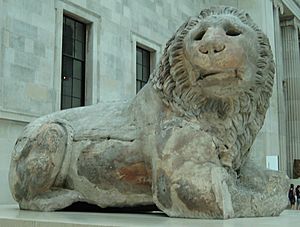Lion of Knidos facts for kids
Quick facts for kids Lion of Knidos |
|
|---|---|

Lion of Knidos
|
|
| Material | Marble |
| Size | 2.89 m long by 1.82 m high |
| Created | c. 350-200 BC |
| Present location | British Museum, London |
| Registration | 1859,1226.24 |
The Lion of Knidos is a huge ancient Greek statue. It was first found by British archaeologists in 1858. They saw it near the old port of Knidos, which is in what is now Turkey. Soon after it was found, the statue was moved to London. It became part of the British Museum's collection.
Experts have different ideas about how old the sculpture is. Most think it was made around the 2nd century BC. Since the year 2000, the Lion of Knidos has been proudly shown on a stand. You can see it under the roof of the Queen Elizabeth II Great Court at the British Museum.
Contents
What the Lion of Knidos Looks Like
This statue shows a lion lying down. It was carved from marble taken from Mount Pentelikon near Athens. This is the same type of marble used to build the famous Parthenon. The lion statue is mostly complete. Only its lower jaw and front legs are missing. Its eyes might have once had glass in them.
The statue is bigger than a real lion. It weighs six tons and is 2.89 meters long and 1.82 meters high. The inside of the statue was made hollow from below. This helped to make it lighter.
The Monument and Its History
The Lion of Knidos sat on top of a monument built for someone who had died. This style of monument was popular around 350 BC in Halikarnassos. That city was only a day's boat trip away. The monument was square with a stepped, pyramid-shaped top. It was hollow inside with a round shape.
Because of this style, some experts think the statue was made around 350 BC. But others believe the statue was on top of a cenotaph. A cenotaph is a monument for people buried somewhere else. They think it was built to remember the naval Battle of Cnidus in 394 BC. In that battle, the Athenian general Conon led a combined Athenian and Persian fleet. They won against a Spartan fleet led by Peisander.
A third idea is that the monument's design, called Doric, looks more like it's from 175 BC. The British Museum estimates the statue's age to be between 250 and 200 BC. The rest of the monument is still in Turkey. It has been dug up by the British Museum. It was originally 12 meters square. Digs at the site haven't found any other objects or writings that could tell us the exact date of the statue.
How the Lion Was Found
The Lion of Knidos was first seen in 1858. It was found by a British archaeologist named Richard Popplewell Pullan. He was walking along the cliffs near what is now the Turkish town of Datça. Pullan was helping Charles Thomas Newton dig up the ancient Greek city of Knidos nearby.
The statue had been at the very top of an 18-meter-high monument. This monument had amazing views over the sea. It might have even helped sailors find their way. The monument might have been destroyed by an earthquake. The statue was found lying some distance away from where the tomb was.
The Knidos Lion was moved with some difficulty down the coast. There, it was loaded onto a naval ship called HMS Supply by Robert Murdoch Smith. Then it was shipped to London. Smith played an important part in this. He found the large statue lying on its front. The main part of the monument, made of limestone, was still there. But the marble covering had either been stolen or had fallen off. Smith was able to put the remaining stones back together and move them. This allowed Pullan, who was an architect, to draw a good picture of what the whole monument might have looked like.
In 2008, the Turkish town of Datça asked the British Ministry of Culture and Tourism to return two statues. These were the Lion of Knidos and the Demeter of Knidos.
See also
 In Spanish: León de Cnido para niños
In Spanish: León de Cnido para niños


